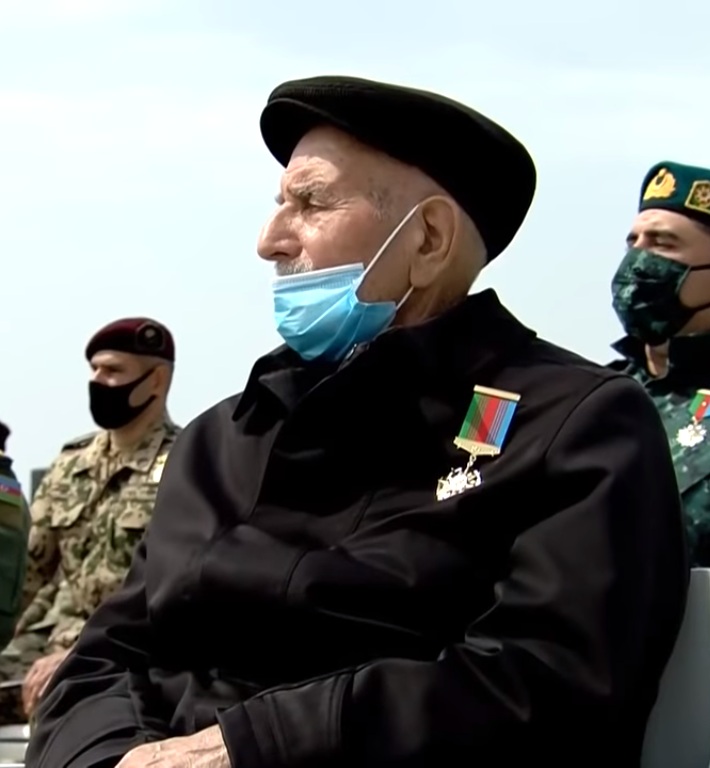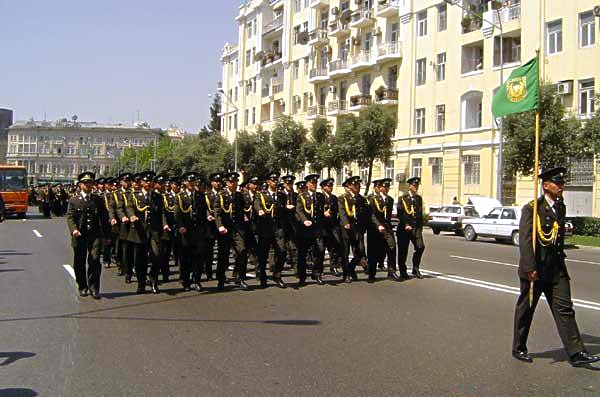|
Shukur Hamidov
Shukur Nariman oğlu Hamidov ( az, Şükür Həmidov) (1 April 1975 – 22 October 2020) was an Azerbaijani officer, national hero and colonel of the Armed Forces of Azerbaijan. He was son to Nariman and Shargiya Hamidov. He was an enlisted member of the army since a young age and had experienced multiple wars. His family were refugees from Armenia that later migrated to Azerbaijan. Shukur Hamidov was an attributed soldier with multiple accolades and awards to his name and his legacy follows him with his name being immortalised in the Qubadli district along with a school being named after him in the same country. His relations include Zakir Hasanov, the President of Azerbaijan Ilham Aliyev, late Polad Hashimov and Mais Barkhudarov & Khudayar Yusifzade others. Biography Shukur Hamidov was born in the Qubadli District of Azerbaijan SSR. He was the 9th child in the family of Nariman & Shargaya Hamidov. His father gave him the name of his own father. Since 8th class Shuk ... [...More Info...] [...Related Items...] OR: [Wikipedia] [Google] [Baidu] |
Qubadli District
Qubadli District ( az, Qubadlı rayonu) is one of the 66 districts of Azerbaijan. It is located in the south-west of the country and belongs to the East Zangezur Economic Region. The district borders the districts of Lachin, Khojavend, Jabrayil, Zangilan, and the Syunik Province of Armenia. Its capital and largest city is Qubadli. As of 2020, the district had a nominal population of 41,600. History The region was part of the Kurdistansky Uyezd and later the Kurdistan Okrug in the Azerbaijani SSR from 7 July 1923 to 23 July 1930. To its Kurdish population, it was known as Qûbadlî. The district was established on 14 March 1933. The district came was seized by the breakaway Republic of Artsakh in August 1993 during the First Nagorno-Karabakh War. Azerbaijani forces regained control of all of the district during the 2020 Nagorno-Karabakh war. Demographics According to the last Soviet census of 1989, population was 28,110. According to undated Azerbaijani data, the popula ... [...More Info...] [...Related Items...] OR: [Wikipedia] [Google] [Baidu] |
Mais Barkhudarov
Mais Barkhudarov ( az, Mais Bərxudarov) is an Azerbaijani officer, lieutenant general of Armed Forces of Azerbaijan, who was a participant of 2016 Nagorno-Karabakh clashes and 2020 Nagorno-Karabakh war. He is the current commander of the 2nd Army Corps of Azerbaijan. Biography Mais Barkhudarov was born in Qubadli, Azerbaijan SSR. Since childhood he was fond of wrestling. He was taught by wrestler Aliyar Aliyev, who later participated in the first Karabakh war and became a National Hero of Azerbaijan (posthumously). Events unfolding in those years in Karabakh led Barkhudarov in the Jamshid Nakhchivanski Military Lyceum.Lələ-təpə qəhrəmanı Mais Bərxudarov haqda deyilə bilənlər... // Həftə içi, 20 April 2016. Head of the lyceum General [...More Info...] [...Related Items...] OR: [Wikipedia] [Google] [Baidu] |
2010 Nagorno-Karabakh Clashes
The 2010 Nagorno-Karabakh clashes were a series of exchanges of gunfire that took place on February 18 on the line of contact dividing Azerbaijani and the Karabakh Armenian military forces. Azerbaijan accused the Armenian forces of firing on the Azerbaijani positions near Tap Qaraqoyunlu, Qızıloba, Qapanlı, Yusifcanlı and Cavahirli villages, as well as in uplands of Agdam Rayon with small arms fire including snipers. As a result, three Azerbaijani soldiers were killed and one wounded. The engagement became the second deadliest ceasefire violation since 1994, after the 2008 Mardakert clashes. Incidents The incidents embraced two regions in Nagorno-Karabakh (Tartar Rayon, Agdam Rayon) and one region out of it (Goranboy Rayon). Azerbaijani sources claim that on 13:00 local time the Karabakh Armenian military fired from Talysh towards the Azerbaijani positions in Tap Qaraqoyunlu. Accordingly, at 15:00 Armenian troops allegedly opened fire from Agdam Rayon, killing one Aze ... [...More Info...] [...Related Items...] OR: [Wikipedia] [Google] [Baidu] |
2008 Mardakert Skirmishes
The 2008 Mardakert clashes began on March 4 after the 2008 Armenian election protests. It involved the heaviest fighting between Nagorno-Karabakh Defense Army, ethnic Armenian and Military of Azerbaijan, Azerbaijani forces over the disputed region of Nagorno-Karabakh since the Bishkek Protocol, 1994 ceasefire after the First Nagorno-Karabakh War. Armenian sources accused Azerbaijan of trying to take advantage of ongoing unrest in Armenia. Azerbaijani sources blamed Armenia, claiming that the Armenian government was trying to divert attention from internal tensions in Armenia. Following the incident, on March 14 the United Nations General Assembly by a recorded vote of 39 in favour to 7 against adopted United Nations General Assembly Resolution 62/243, Resolution 62/243, demanding the immediate withdrawal of all Armenian forces. Background First Nagorno-Karabakh War During and shortly after the dissolution of the Soviet Union, Armenians in the Nagorno-Karabakh Autonomous Oblast a ... [...More Info...] [...Related Items...] OR: [Wikipedia] [Google] [Baidu] |
National Hero Of Azerbaijan
The National Hero of Azerbaijan ( az, Azərbaycan milli qəhrəmanı) is the highest Hero (title), national title in the Republic of Azerbaijan. The title was named on 25 March 1992, and the "Qizil Ulduz" Medal awarded as a sign of receiving this title was established by a separate law in 15 July 1992. The law on the title has been in effect since 25 December 1995. It can only be awarded once to the same person. The title is awarded for outstanding services of national importance to Azerbaijan in defence and strengthening of the state system and creation of important national values. Independent Azerbaijan After the Dissolution of the Soviet Union, break-up of the Soviet Union in 1991, Azerbaijan and Armenia were engaged in the First Nagorno-Karabakh War in which several Azerbaijanis were awarded with the ''National Hero of Azerbaijan''. Recipients * Mubariz Ibrahimov * Maharram Seyidov * Albert Agarunov * Kerim Kerimov (National Hero of Azerbaijan), Kerim Kerimov * Riad Ahmad ... [...More Info...] [...Related Items...] OR: [Wikipedia] [Google] [Baidu] |
Jabrayil District
Jabrayil District ( az, Cəbrayıl rayonu) is one of the 66 districts of Azerbaijan. It is located in the south-west of the country and belongs to the East Zangezur Economic Region. The district borders the districts of Khojavend, Fuzuli, Qubadli, Zangilan, and the Islamic Republic of Iran. Its capital is Jabrayil, however since the city is completely ruined following its occupation by ethnic Armenian forces, the current ''de facto'' capital is Jojug Marjanly until Jabrayil is rebuilt. As of 2020, the district had a nominal population of 81,700. Etymology The name of Jabrayil was taken from the name of the village Jabrayil that was the centre of the region. Father Jabrayil, who was the founder of the village Jabrayil, was one of the closes of the ruler by name Sultan Ahmed who lived in VIII century and the territories between Zuyaret Mountain and the river Araz belonged to Father Jabrayil and his sons. History In pre-modern times, the current territory of Jabrayil Distr ... [...More Info...] [...Related Items...] OR: [Wikipedia] [Google] [Baidu] |
Lalatapa
Lalatapa ( az, Lələ Təpə, ) is a high hill in the Jabrayil Rayon of Azerbaijan, north-west of Çocuq Mərcanlı. Having a strategic military importance, the hill was one of the battle sites during the First Nagorno-Karabakh War on February 11–12, 1994, following which it was seized by Armenian troops. Lalatapa was retaken by Azerbaijani forces during the 2016 Nagorno-Karabakh conflict, which was independently confirmed by an AFP journalist. After the 2020 Nagorno-Karabakh war, in April 2021, the hill again entered public discourse in Armenia when opponents of the Prime Minister of Armenia Nikol Pashinyan accused him of ordering a failed operation to capture Lalatapa in early October 2020, resulting in severe casualties for the Armenian side and the collapse of the Armenian defense on the southeastern part of the front. Pashinyan rejected this accusation, saying that the operation was proposed and planned by generals and that he merely moderated the discussion between them ... [...More Info...] [...Related Items...] OR: [Wikipedia] [Google] [Baidu] |
Colonel Shukur Hamidov In 2017 (2)
Colonel (abbreviated as Col., Col or COL) is a senior military officer rank used in many countries. It is also used in some police forces and paramilitary organizations. In the 17th, 18th and 19th centuries, a colonel was typically in charge of a regiment in an army. Modern usage varies greatly, and in some cases, the term is used as an honorific title that may have no direct relationship to military service. The rank of colonel is typically above the rank of lieutenant colonel. The rank above colonel is typically called brigadier, brigade general or brigadier general. In some smaller military forces, such as those of Monaco or the Vatican, colonel is the highest rank. Equivalent naval ranks may be called captain or ship-of-the-line captain. In the Commonwealth's air force ranking system, the equivalent rank is group captain. History and origins By the end of the late medieval period, a group of "companies" was referred to as a "column" of an army. According to Raymond ... [...More Info...] [...Related Items...] OR: [Wikipedia] [Google] [Baidu] |
First Nagorno-Karabakh War
The First Nagorno-Karabakh War, referred to in Armenia as the Artsakh Liberation War ( hy, Արցախյան ազատամարտ, Artsakhyan azatamart) was an ethnic conflict, ethnic and territorial conflict that took place from February 1988 to May 1994, in the enclave of Nagorno-Karabakh in southwestern Azerbaijan, between the majority ethnic Armenians of Nagorno-Karabakh backed by Armenia, and the Republic of Azerbaijan. As the war progressed, Armenia and Azerbaijan, both former Republics of the Soviet Union, Soviet Republics, entangled themselves in protracted, undeclared mountain warfare in the mountainous heights of Karabakh as Azerbaijan attempted to curb the secessionist movement in Nagorno-Karabakh. The National Assembly (Nagorno-Karabakh), enclave's parliament had voted in favor of uniting with Armenia and a referendum, boycotted by the Azerbaijani population of Nagorno-Karabakh, was held, in which a majority voted in favor of independence. The demand to unify with Arme ... [...More Info...] [...Related Items...] OR: [Wikipedia] [Google] [Baidu] |
Azerbaijan Higher Military Academy
The Azerbaijan Higher Military Academy named after Heydar Aliyev (, russian: Азербайджанское высшее военное училище имени Гейдара Алиева) is an educational institution of the Azerbaijani Armed Forces. In order to be admitted into the academy, candidates have to be between the ages of 17 and 19 and have completed secondary school education. Background The predecessor institution to the current academy was the Baku Higher Combined Arms Command School (BVOKU), which was founded on 29 November 1939 as one of many military academies of the Soviet Army. By 1951, the developing school was ranked 6th place among the best infantry schools in the USSR. The school was disbanded in 1991 as a result of the fall of the Soviet Union. Among the notable alumni of the BVOKU are former Defense Minister of Armenia Seyran Ohanyan, Minister of Defense of Azerbaijan Zakir Hasanov and Armenian military leader during the Karabakh War Arkady Ter-Tade ... [...More Info...] [...Related Items...] OR: [Wikipedia] [Google] [Baidu] |
Jamshid Nakhchivanski Military Lyceum
Jamshid Nakhchivanski Military Lyceum ( az, Cəmşid Naxçıvanski adına Hərbi Lisey), also known as Military Lyceum named after Jamshid Nakhchivanski, is a state school, specializing in education and training of students in military science and preparing them for professional military service. The lyceum is located in the suburbs of Baku, Azerbaijan. History The lyceum was established on July 28, 1971 by the decree No. 331 of the Central Committee of the Communist Party of Azerbaijan SSR at initiative of the First Secretary of Azerbaijan Communist Party and later President of Azerbaijan, Heydar Aliyev on the basis of an eight-year Baku boarding school No. 2. The initial name of the school was "Specialized boarding school of the republic". The school was subordinated to the Ministry of Education of Azerbaijan SSR. In November 1971, Heydar Aliyev named it after Azerbaijani general, Major General Jamshid Nakhchivanski. Nakhchivanski was a well known military professional who libera ... [...More Info...] [...Related Items...] OR: [Wikipedia] [Google] [Baidu] |

_-_lent.png)
